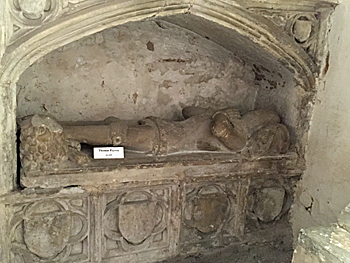The Hospital of Saint John the Baptist Toddington

The tomb of Thomas Peyvre June 2015
The Hospital of Saint John the Baptist at Toddington was founded in 1433 by John Broughton "for a Chaplain and warden and three poor men" who were to pray for King Henry VI (1422-1461 and 1470-1471), for Broughton himself, and for Thomas Peyvre and his wife Margaret. The lands with which the Hospital was endowed probably included the meadow in which Conger Hill (originally the motte of Toddington Castle) stands and it is likely that the Hospital itself was built over the remains of the outer bailey of the castle. By 1538 the Hospital was occupied by a warden or master and three chaplains rather than the three poor men specified by its founder, with stipends of £8.13s.2d for the master and £5.13s.4d, £5, and £8.12s.4d for the other three priests. The master at this time, John Mylward was the compiler of De potestate Petri ("The Power of Peter"), a collection of writings of the Fathers of the Church in defence of the papal supremacy. He was examined in 1538 along with the monks of Woburn who were subsequently executed for opposing King Henry VIII's break with Rome, but although he acknowledged that he was responsible for the book and that he had not promoted the royal supremacy in his sermons his subtle and non-committal responses to his questioners seem to have saved him from being brought to trial.
In 1546 the Chantry Certificate states that the Hospital was "dissolved already without the king's majesty's license" and that "the said hospital and the use thereof ceased immediately after the death of Sir John Mylward, late parson thereof". The value of the warden's stipend was given as £13 2s. Since the dissolution no money had been paid to the poor, and the property of the Hospital had been divided between two daughters of Sir John Broughton. In 1572 both the site and the land were granted to William, James and John Grey, but in practice the endowed land continued to be held by the lord of Toddington. This endowment was adjacent to the glebe and tithe land known as the Portionaries which was also held with the manor property.
The Hospital building itself is believed to have been on a site adjacent to the Church on land now part of Griffin Farm. Medieval wall foundations were found during building work in the Griffin farmyard in the early 19th century. The lower part of the churchyard wall on the eastern side probably formed the western wall of the chapel. The former Hospital was pulled down in the 16th century and the materials are said to have been used to build the market hall. The last known reference to the building comes in the Patent Roll for 1572 in which it is called Brotherhood House. In the Bishop of Lincoln's visitation record for 1706 it states "the Hospital is demolished" [BHRS,81].